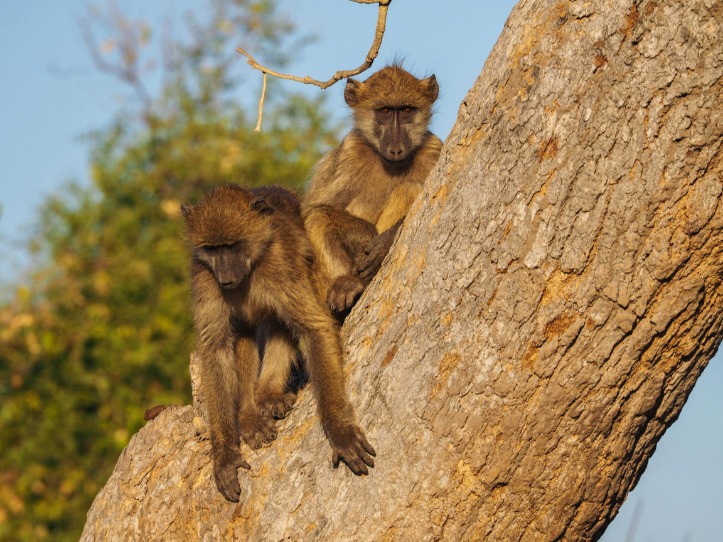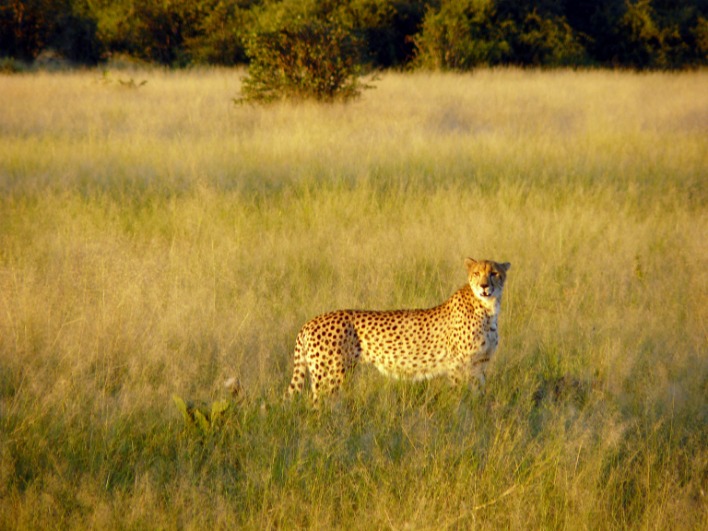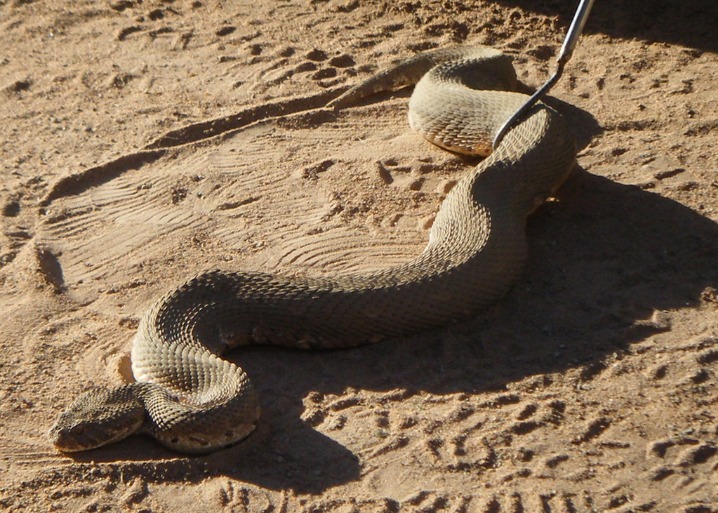Major Wildlife in Botswana
Botswana is renowned for its rich biodiversity and is home to some of Africa’s most iconic wildlife. The country’s vast savannas, lush wetlands, and national parks provide a sanctuary for a diverse array of wildlife species. From majestic elephants to fierce predators, Botswana’s animals play a vital role in maintaining the ecological balance and attracting eco-tourists from around the world.
Big Cats
Botswana is renowned for its diverse and abundant wildlife, making it a premier destination for nature enthusiasts. Among its many fascinating creatures, big cats such as lions, leopards, and cheetahs stand out as some of the most iconic and captivating animals in the region. These majestic predators play a crucial role in maintaining the ecological balance of Botswana’s savannas and wilderness areas.
Lions, often called the “King of Beasts,” are frequently seen across Botswana’s national parks and game reserves, where they form impressive prides that showcase their social structure and hunting prowess. Leopards are known for their elusive nature and stunning spotted coats, deftly navigating the trees and terrain to hunt and evade danger. Cheetahs, the fastest land animals, are also present in Botswana, primarily in open plains where they can utilize their incredible speed for hunting prey.
In addition to these big cats, Botswana is home to other notable wildlife such as elephants, buffaloes, and rhinos, which coexist in the vast wilderness areas. The conservation efforts in Botswana have helped protect these species, ensuring that future generations can continue to marvel at the incredible wildlife that defines the country’s natural heritage.
Elephants
Botswana is renowned for its rich biodiversity and diverse wildlife, with elephants being one of the most iconic animals in the region. These majestic creatures roam across the country’s vast national parks and Game Reserves, symbolizing the wilderness of Botswana.
- Elephants are the largest land animals in the world, and Botswana hosts one of the largest populations in Africa.
- They play a vital role in maintaining the ecological balance by shaping their environment through activities like tree pruning and water source creation.
- The Okavango Delta and Chobe National Park are especially famous for their large concentrations of elephants, making Botswana a top destination for elephant safaris.
- Conservation efforts in Botswana have helped protect these magnificent animals from threats such as poaching and habitat loss.
- Elephants in Botswana can sometimes be seen migrating in large herds, which is a spectacular sight for visitors and wildlife enthusiasts alike.
Cheaters and Predators
Botswana is renowned for its rich diversity of wildlife, offering a haven for numerous species of mammals, birds, and insects. Major wildlife in Botswana includes elephants, lions, leopards, buffaloes, and rhinos, which thrive in the country’s expansive national parks such as Chobe and Okavango Delta. These animals play vital roles in maintaining ecological balance and attract many eco-tourists from around the world.
Within this vibrant ecosystem, some animals are notable cheaters and predators. Lions, for example, are apex predators famous for hunting large herbivores such as zebras, wildebeests, and buffalo. Leopards are stealthy predators that often hunt smaller animals like antelopes and rodents, skillfully ambushing their prey from concealed locations. Crocodiles, found in rivers and water bodies, are also significant predators, preying on fish, birds, and even young mammals that venture close to water. These predators are essential for controlling prey populations and maintaining the health of Botswana’s wildlife habitats.
Wild Dogs
Botswana is renowned for its rich biodiversity and diverse wildlife, making it a top destination for nature enthusiasts. Among its major wildlife, wild dogs stand out as one of the most fascinating and social predators. Also known as African painted wolves, wild dogs are highly intelligent, cooperative hunters that live in large packs, which allows them to successfully hunt a variety of prey across Botswana’s expansive savannahs and national parks. Their striking coat patterns and strong social bonds contribute to their unique presence in Botswana’s ecosystems. Protecting wild dogs is crucial for maintaining the ecological balance and ensuring the continued health of Botswana’s wilderness areas.
Lions
Botswana is renowned for its rich diversity of wildlife, notably its iconic lions that roam the savannahs and national parks. These majestic predators play a crucial role in maintaining the balance of the ecosystem and attracting eco-tourists from around the world.
- Lions are the top predators in Botswana’s wilderness, primarily found in the Okavango Delta, Chobe National Park, and Moremi Game Reserve.
- They are known for their strength, coordination, and social structure, living in groups called prides.
- Botswana’s lions are famous for their impressive size and the ability to adapt to various habitats within the country.
- The conservation efforts in Botswana have helped sustain healthy lion populations despite threats from poaching and human-wildlife conflict.
- Seeing lions in their natural habitat is one of the main attractions for visitors seeking a true African safari experience.
Leopards
Leopards are one of the most significant and captivating wildlife species found in Botswana. As elusive and graceful predators, they play a crucial role in maintaining the ecological balance within the country’s diverse habitats. Botswana’s vast savannas, forests, and wetlands provide an ideal environment for leopards to thrive, offering abundant prey and secluded territories for stalking. These magnificent creatures are known for their distinctive spotted coats, excellent climbing abilities, and nocturnal habits, which help them avoid human conflict and conserve energy during the heat of the day. Recognized as a symbol of the rich biodiversity of Botswana, leopards attract many wildlife enthusiasts and conservation efforts aimed at protecting their populations from threats such as poaching and habitat loss. Their presence underscores the importance of maintaining Botswana’s pristine ecosystems for future generations to enjoy and study.
Bird Species of Botswana
Botswana is a remarkable country teeming with diverse wildlife, including a wide array of bird species that enrich its ecosystems. From sprawling wetlands to vast desert landscapes, the birdlife in Botswana offers a fascinating glimpse into the region’s natural beauty. Bird enthusiasts and nature lovers alike can enjoy observing an array of species, each uniquely adapted to the country’s varied habitats. Exploring the bird species of Botswana provides insight into the vibrant life that thrives in this African jewel.
Ostriches
Botswana is home to a diverse range of bird species, including the iconic ostrich, which is the world’s largest bird. Ostriches are well-adapted to the arid and semi-arid environments found in Botswana, thriving in open savannas and grasslands. They are easily recognizable by their tall stature, long necks, and powerful legs, which enable them to run at impressive speeds to escape predators. These birds are also notable for their large eggs, which are the largest of any bird species. Ostriches play an important role in the ecosystems of Botswana, both as grazers and as prey for larger predators. Their presence adds to the rich avian biodiversity that makes Botswana a popular destination for birdwatchers and nature enthusiasts.
Secretary Birds
Secretory Birds are one of the most fascinating bird species found in Botswana, renowned for their distinctive appearance and unique hunting behavior. These striking birds are part of the secretary bird family and are easily recognizable by their long legs and elegant, kite-like wings. They play a significant role in the ecosystem of Botswana’s savannas and open plains.
- Scientific Name: Sagittarius serpentarius
- Habitat: Grasslands, open plains, and savannas of Botswana
- Diet: Primarily insects, small mammals, and reptiles
- Physical Description: Tall stature with long legs, crest of feathers on the head, and striking black and white plumage
- Behavior: Known for their distinctive hunting style, which involves stomping on prey and using their sharp beak to kill
Secretory Birds are considered a symbol of the wild and untouched nature of Botswana’s diverse fauna, contributing to the unique animal heritage of the region.
Kingfishers
Kingfishers are a vibrant and fascinating group of bird species commonly found in Botswana. These birds are known for their striking colors and exceptional fishing skills, making them a notable part of Botswana’s diverse wildlife.
- Pied Kingfisher
- Malachite Kingfisher
- Giant Kingfisher
- Woodland Kingfisher
- ISpot-banded Kingfisher
Vultures
Botswana is home to a diverse range of bird species, including several vulture species that play a vital role in the ecosystem. These vultures are essential scavengers, helping to clean up carcasses and prevent the spread of disease. Their presence highlights the rich biodiversity of Botswana’s wildlife conservation efforts.
- White-backed Vulture (Gyps africanus): Recognizable by its white back and essential for the region’s food chain.
Stocks and Waterfowl
Botswana is home to a diverse range of bird species, particularly noted for its waterfowl and aquatic birds. The country’s wetlands, rivers, and lakes provide ideal habitats for many waterbird species, making it a popular destination for birdwatching enthusiasts.
- Egyptian Goose
- Marabou Stork
- African Fish Eagle
- Great White Pelican
- African Jacana
- Malachite Kingfisher
- Pink-backed Pelican
- African Spoonbill
- Gyps Vultures
- Lapwing species
Stock species in Botswana include various migratory and resident birds, such as herons, storks, and ducks, which thrive in the country’s aquatic environments. Waterfowl like teal, wigeon, and shovelers are commonly seen during migration seasons, highlighting Botswana’s significance as a sanctuary for avian biodiversity.
Unique and Endemic Animals
Botswana is home to a diverse array of unique and endemic animals that thrive in its rich ecosystems. These animals, often found only within the country’s borders, contribute to the region’s remarkable biodiversity. Exploring the wildlife of Botswana reveals fascinating species that have adapted to its various habitats, making the country a premier destination for nature enthusiasts and conservationists alike.
Heck’s Goby
Botswana is renowned for its rich biodiversity and the presence of unique and endemic animals that contribute to its ecological significance. Among these remarkable species is Heck’s Goby, a small freshwater fish notable for its limited distribution and specialized habitat. Endemic to certain river systems within Botswana, Heck’s Goby exemplifies the country’s exceptional aquatic fauna. Protecting such species is crucial for maintaining the ecological balance and conserving Botswana’s natural heritage.
Sanare Cichlid
Sanare Cichlid is a unique and endemic animal found exclusively in a specific freshwater habitat within Botswana. This vibrant fish is highly regarded for its striking coloration and distinctive markings, making it a fascinating subject for fish enthusiasts and biologists alike. As an endemic species, the Sanare Cichlid plays a vital role in the local ecosystem, contributing to the biodiversity of Botswana’s aquatic life. Protecting such unique species is crucial to preserving the natural heritage and environmental health of the region.
Southern Africa Ostrich
The Southern Africa Ostrich, scientifically known as Struthio camelus australis, is a unique and endemic bird species found primarily in Botswana. As the world’s largest bird, the ostrich is well adapted to the arid and semi-arid environments of southern Africa. Its impressive size, long legs, and neck enable it to run at high speeds to escape predators. Ostriches play an important role in Botswana’s ecosystem by controlling insect populations and serving as a source of food and cultural significance for local communities. Due to its adaptation to specific habitats, the Southern Africa Ostrich is considered an iconic and endemic species within the region, showcasing the rich biodiversity of Botswana.
Conservation and Protected Species
Conservation of protected species is essential for maintaining the rich biodiversity of Botswana, a country renowned for its diverse wildlife. Efforts to safeguard these animals help preserve the ecological balance and ensure that future generations can experience the unique fauna that Botswana has to offer. From majestic elephants to elusive predators, protecting these species is crucial for sustaining the natural heritage of the region.
Endangered Animals
Botswana is renowned for its rich diversity of wildlife, including many species that are regarded as endangered or protected. Conservation efforts in the country focus on preserving iconic animals such as elephants, lions, leopards, and rhinoceroses, which face threats from poaching, habitat loss, and climate change.
The Botswana government, together with various conservation organizations, has implemented numerous initiatives to safeguard these species. This includes establishing national parks like the Okavango Delta, Chobe National Park, and Moremi Game Reserve, which serve as vital habitats for wildlife and promote eco-tourism.
Many of Botswana’s animals are protected by law, with strict regulations against poaching and illegal wildlife trade. International agreements such as CITES help ensure the sustainable management and protection of endangered species. Community-based conservation programs also involve local populations in protecting wildlife and generating sustainable livelihoods.
Despite these efforts, challenges remain, especially with the increasing risk of poaching driven by high demand for ivory and rhino horn. Continued commitment and collaboration are essential to ensure that Botswana’s unique fauna remains thriving for future generations.

Conservation Efforts
Botswana is renowned for its rich biodiversity and the diverse array of animal species that inhabit its landscapes. Conservation efforts in the country are vital to protect these species from threats such as poaching, habitat loss, and climate change. Botswana’s commitment to preserving its wildlife has led to the establishment of numerous protected areas and national parks, dedicated to safeguarding its unique fauna.
- Efforts to combat poaching of endangered species like elephants and rhinoceroses.
- Creation of national parks such as Okavango Delta, Chobe National Park, and Central Kalahari Game Reserve.
- Community-based conservation programs involving local communities to promote sustainable tourism and wildlife protection.
- Anti-poaching patrols equipped with modern technology to monitor and prevent illegal activities.
- Research and wildlife monitoring initiatives to understand population dynamics and habitat needs.
- Environmental education campaigns aimed at raising awareness about the importance of conservation.
Through these concerted efforts, Botswana continues to be a sanctuary for numerous species, ensuring their survival for future generations and maintaining the ecological balance of the region.
Habitats and Ecosystems
Botswana, a country renowned for its rich wildlife, is home to a diverse array of habitats and ecosystems that support an incredible variety of animals. From expansive savannas and grasslands to shimmering wetlands and dense forests, these environments provide vital resources and shelter for many species. Understanding these habitats is essential to appreciating the unique animals that inhabit Botswana and their roles in maintaining ecological balance.

Savannahs and Grasslands
Botswana is renowned for its diverse habitats and ecosystems, which support a wide variety of animal species. Among these, savannahs and grasslands are the most prominent, covering much of the country’s landscape. These regions provide essential resources such as water, food, and shelter, creating ideal environments for many animals to thrive.
The savannahs in Botswana are characterized by tall grasses interspersed with scattered trees, making them perfect habitats for large mammals like elephants, lions, cheetahs, and giraffes. These ecosystems are also home to herbivores such as zebras and antelopes, which find abundant grazing opportunities.
Grasslands dominate much of Botswana and play a crucial role in supporting a range of wildlife. They are vital for migratory species and serve as breeding grounds for various birds and insects. The health of these ecosystems is essential for maintaining the rich biodiversity that Botswana is famous for, especially within national parks like the Okavango Delta and Chobe National Park.
Overall, Botswana’s savannahs and grasslands are integral to the survival of many unique animal species, making conservation efforts vital for preserving these vital habitats for future generations.
Desert Ecosystems
Desert ecosystems are unique environments characterized by extreme temperatures, low precipitation, and specialized plant and animal life. In Botswana, deserts such as the Kalahari Desert provide a habitat for a variety of adapted species that thrive in harsh conditions. These animals have evolved to conserve water and withstand fierce heat, making deserts a fascinating part of Botswana’s biodiversity. Notable desert animals include meerkats, coyotes, and various reptiles that are well-suited to this arid landscape. The desert ecosystem plays a crucial role in maintaining ecological balance and supporting the survival of many specialized species in Botswana.
Wetlands and Waterholes
Botswana is home to a variety of habitats and ecosystems that support diverse wildlife populations. Wetlands and waterholes are especially vital areas where animals gather to drink, feed, and socialize, creating vibrant hubs of activity. These environments are rich in plant life and provide crucial resources, making them essential for the survival of many species such as elephants, lions, hippos, and numerous bird species. Protecting these habitats ensures the sustainability of Botswana’s unique animal populations and maintains the natural balance of its ecosystems.
Forests and Riverine Areas
Botswana is renowned for its rich habitats and diverse ecosystems, which support a wide variety of animal life. Forested regions provide shelter and food for numerous species such as monkeys, birds, and insects, creating a vibrant and balanced environment. Riverine areas, including the Okavango Delta and Chobe River, are vital habitats that sustain large populations of aquatic creatures, migratory birds, and large mammals like elephants and hippos. These ecosystems play a crucial role in maintaining biodiversity and offer critical resources for both wildlife and local communities. The interconnectedness of forests and riverine zones in Botswana highlights the importance of preserving these habitats to ensure the continued survival of its unique fauna.





0 Comments